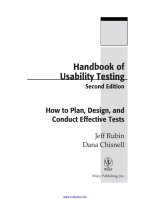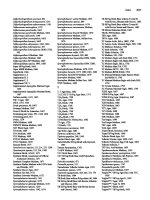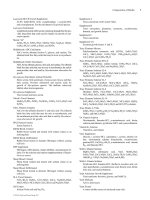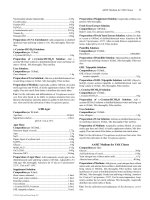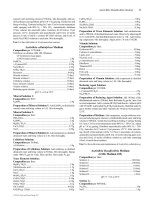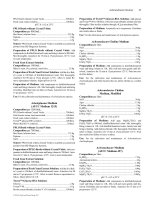Handbook of data compression, 5th edition
Bạn đang xem bản rút gọn của tài liệu. Xem và tải ngay bản đầy đủ của tài liệu tại đây (16.93 MB, 1,370 trang )
www.it-ebooks.info
Handbook of Data Compression
Fifth Edition
www.it-ebooks.info
David Salomon
Giovanni Motta
With Contributions by David Bryant
Handbook of Data
Compression
Fifth Edition
Previous editions published under the title
“Data Compression: The Complete Reference”
123
www.it-ebooks.info
Prof. David Salomon (emeritus)
Computer Science Dept.
California State University, Northridge
Northridge, CA 91330-8281
USA
Dr. Giovanni Motta
Personal Systems Group, Mobility Solutions
Hewlett-Packard Corp.
10955 Tantau Ave.
Cupertino, Califormia 95014-0770
ISBN 978-1-84882-902-2
e-ISBN 978-1-84882-903-9
DOI 10.1007/10.1007/978-1-84882-903-9
Springer London Dordrecht Heidelberg New York
British Library Cataloguing in Publication Data
A catalogue record for this book is available from the British Library
Library of Congress Control Number: 2009936315
c Springer-Verlag London Limited 2010
Apart from any fair dealing for the purposes of research or private study, or criticism or review, as permitted under the
Copyright, Designs and Patents Act 1988, this publication may only be reproduced, stored or transmitted, in any form
or by any means, with the prior permission in writing of the publishers, or in the case of reprographic reproduction in
accordance with the terms of licenses issued by the Copyright Licensing Agency. Enquiries concerning reproduction
outside those terms should be sent to the publishers.
The use of registered names, trademarks, etc., in this publication does not imply, even in the absence of a specific
statement, that such names are exempt from the relevant laws and regulations and therefore free for general use.
The publisher makes no representation, express or implied, with regard to the accuracy of the information contained in
this book and cannot accept any legal responsibility or liability for any errors or omissions that may be made.
Cover design: eStudio Calamar S.L.
Printed on acid-free paper
Springer is part of Springer Science+Business Media (www.springer.com)
www.it-ebooks.info
To users of data compression everywhere
I love being a writer. What I can’t stand is the paperwork.
—Peter De Vries
www.it-ebooks.info
Preface to the
New Handbook
entle Reader. The thick, heavy volume you are holding in your hands was intended to be the fifth edition of Data Compression: The Complete Reference.
G
Instead, its title indicates that this is a handbook of data compression. What makes
a book a handbook? What is the difference between a textbook and a handbook? It
turns out that “handbook” is one of the many terms that elude precise definition. The
many definitions found in dictionaries and reference books vary widely and do more to
confuse than to illuminate the reader. Here are a few examples:
A concise reference book providing specific information about a subject or location
(but this book is not concise).
A type of reference work that is intended to provide ready reference (but every
reference work should provide ready reference).
A pocket reference is intended to be carried at all times (but this book requires big
pockets as well as deep ones).
A small reference book; a manual (definitely does not apply to this book).
General information source which provides quick reference for a given subject area.
Handbooks are generally subject-specific (true for this book).
Confusing; but we will use the last of these definitions. The aim of this book is to
provide a quick reference for the subject of data compression. Judging by the size of the
book, the “reference” is certainly there, but what about “quick?” We believe that the
following features make this book a quick reference:
The detailed index which constitutes 3% of the book.
The glossary. Most of the terms, concepts, and techniques discussed throughout
the book appear also, albeit briefly, in the glossary.
www.it-ebooks.info
viii
Preface
The particular organization of the book. Data is compressed by removing redundancies in its original representation, and these redundancies depend on the type of
data. Text, images, video, and audio all have different types of redundancies and are
best compressed by different algorithms which in turn are based on different approaches.
Thus, the book is organized by different data types, with individual chapters devoted
to image, video, and audio compression techniques. Some approaches to compression,
however, are general and work well on many different types of data, which is why the
book also has chapters on variable-length codes, statistical methods, dictionary-based
methods, and wavelet methods.
The main body of this volume contains 11 chapters and one appendix, all organized
in the following categories, basic methods of compression, variable-length codes, statistical methods, dictionary-based methods, methods for image compression, wavelet methods, video compression, audio compression, and other methods that do not conveniently
fit into any of the above categories. The appendix discusses concepts of information
theory, the theory that provides the foundation of the entire field of data compression.
In addition to its use as a quick reference, this book can be used as a starting point
to learn more about approaches to and techniques of data compression as well as specific
algorithms and their implementations and applications. The broad coverage makes the
book as complete as practically possible. The extensive bibliography will be very helpful
to those looking for more information on a specific topic. The liberal use of illustrations
and tables of data helps to clarify the text.
This book is aimed at readers who have general knowledge of computer applications, binary data, and files and want to understand how different types of data can be
compressed. The book is not for dummies, nor is it a guide to implementors. Someone
who wants to implement a compression algorithm A should have coding experience and
should rely on the original publication by the creator of A.
In spite of the growing popularity of Internet searching, which often locates quantities of information of questionable quality, we feel that there is still a need for a concise,
reliable reference source spanning the full range of the important field of data compression.
New to the Handbook
The following is a list of the new material in this book (material not included in
past editions of Data Compression: The Complete Reference).
The topic of compression benchmarks has been added to the Introduction.
The paragraphs titled “How to Hide Data” in the Introduction show how data
compression can be utilized to quickly and efficiently hide data in plain sight in our
computers.
Several paragraphs on compression curiosities have also been added to the Introduction.
The new Section 1.1.2 shows why irreversible compression may be useful in certain
situations.
Chapters 2 through 4 discuss the all-important topic of variable-length codes. These
chapters discuss basic, advanced, and robust variable-length codes. Many types of VL
www.it-ebooks.info
Preface
ix
codes are known, they are used by many compression algorithms, have different properties, and are based on different principles. The most-important types of VL codes are
prefix codes and codes that include their own length.
Section 2.9 on phased-in codes was wrong and has been completely rewritten.
An example of the start-step-stop code (2, 2, ∞) has been added to Section 3.2.
Section 3.5 is a description of two interesting variable-length codes dubbed recursive
bottom-up coding (RBUC) and binary adaptive sequential coding (BASC). These codes
represent compromises between the standard binary (β) code and the Elias gamma
codes.
Section 3.28 discusses the original method of interpolative coding whereby dynamic
variable-length codes are assigned to a strictly monotonically increasing sequence of
integers.
Section 5.8 is devoted to the compression of PK (packed) fonts. These are older
bitmaps fonts that were developed as part of the huge TEX project. The compression
algorithm is not especially efficient, but it provides a rare example of run-length encoding
(RLE) without the use of Huffman codes.
Section 5.13 is about the Hutter prize for text compression.
PAQ (Section 5.15) is an open-source, high-performance compression algorithm and
free software that features sophisticated prediction combined with adaptive arithmetic
encoding. This free algorithm is especially interesting because of the great interest it
has generated and because of the many versions, subversions, and derivatives that have
been spun off it.
Section 6.3.2 discusses LZR, a variant of the basic LZ77 method, where the lengths
of both the search and look-ahead buffers are unbounded.
Section 6.4.1 is a description of LZB, an extension of LZSS. It is the result of
evaluating and comparing several data structures and variable-length codes with an eye
to improving the performance of LZSS.
SLH, the topic of Section 6.4.2, is another variant of LZSS. It is a two-pass algorithm where the first pass employs a hash table to locate the best match and to count
frequencies, and the second pass encodes the offsets and the raw symbols with Huffman
codes prepared from the frequencies counted by the first pass.
Most LZ algorithms were developed during the 1980s, but LZPP, the topic of Section 6.5, is an exception. LZPP is a modern, sophisticated algorithm that extends LZSS
in several directions and has been inspired by research done and experience gained by
many workers in the 1990s. LZPP identifies several sources of redundancy in the various quantities generated and manipulated by LZSS and exploits these sources to obtain
better overall compression.
Section 6.14.1 is devoted to LZT, an extension of UNIX compress/LZC. The major
innovation of LZT is the way it handles a full dictionary.
www.it-ebooks.info
x
Preface
LZJ (Section 6.17) is an interesting LZ variant. It stores in its dictionary, which
can be viewed either as a multiway tree or as a forest, every phrase found in the input.
If a phrase is found n times in the input, only one copy is stored in the dictionary. Such
behavior tends to fill the dictionary up very quickly, so LZJ limits the length of phrases
to a preset parameter h.
The interesting, original concept of antidictionary is the topic of Section 6.31. A
dictionary-based encoder maintains a list of bits and pieces of the data and employs this
list to compress the data. An antidictionary method, on the other hand, maintains a
list of strings that do not appear in the data. This generates negative knowledge that
allows the encoder to predict with certainty the values of many bits and thus to drop
those bits from the output, thereby achieving compression.
The important term “pixel” is discussed in Section 7.1, where the reader will discover
that a pixel is not a small square, as is commonly assumed, but a mathematical point.
Section 7.10.8 discusses the new HD photo (also known as JPEG XR) compression
method for continuous-tone still images.
ALPC (adaptive linear prediction and classification), is a lossless image compression algorithm described in Section 7.12. ALPC is based on a linear predictor whose
coefficients are computed for each pixel individually in a way that can be mimiced by
the decoder.
Grayscale Two-Dimensional Lempel-Ziv Encoding (GS-2D-LZ, Section 7.18) is an
innovative dictionary-based method for the lossless compression of grayscale images.
Section 7.19 has been partially rewritten.
Section 7.40 is devoted to spatial prediction, a combination of JPEG and fractalbased image compression.
A short historical overview of video compression is provided in Section 9.4.
The all-important H.264/AVC video compression standard has been extended to
allow for a compressed stream that supports temporal, spatial, and quality scalable
video coding, while retaining a base layer that is still backward compatible with the
original H.264/AVC. This extension is the topic of Section 9.10.
The complex and promising VC-1 video codec is the topic of the new, long Section 9.11.
The new Section 11.6.4 treats the topic of syllable-based compression, an approach
to compression where the basic data symbols are syllables, a syntactic form between
characters and words.
The commercial compression software known as stuffit has been around since 1987.
The methods and algorithms it employs are proprietary, but some information exists
in various patents. The new Section 11.16 is an attempt to describe what is publicly
known about this software and how it works.
There is now a short appendix that presents and explains the basic concepts and
terms of information theory.
www.it-ebooks.info
Preface
xi
We would like to acknowledge the help, encouragement, and cooperation provided
by Yuriy Reznik, Matt Mahoney, Mahmoud El-Sakka, Pawel Pylak, Darryl Lovato,
Raymond Lau, Cosmin Trut¸a, Derong Bao, and Honggang Qi. They sent information,
reviewed certain sections, made useful comments and suggestions, and corrected numerous errors.
A special mention goes to David Bryant who wrote Section 10.11.
Springer Verlag has created the Springer Handbook series on important scientific
and technical subjects, and there can be no doubt that data compression should be
included in this category. We are therefore indebted to our editor, Wayne Wheeler,
for proposing this project and providing the encouragement and motivation to see it
through.
The book’s Web site is located at www.DavidSalomon.name. Our email addresses
are and and readers are encouraged to message us
with questions, comments, and error corrections.
Those interested in data compression in general should consult the short section
titled “Joining the Data Compression Community,” at the end of the book, as well as
the following resources:
/> /> and
o/.
(URLs are notoriously short lived, so search the Internet.)
David Salomon
Giovanni Motta
The preface is usually that part of a
book which can most safely be omitted.
—William Joyce, Twilight Over England (1940)
www.it-ebooks.info
Preface to the
Fourth Edition
(This is the Preface to the 4th edition of Data Compression: The Complete Reference,
the predecessor of this volume.) I was pleasantly surprised when in November 2005
a message arrived from Wayne Wheeler, the new computer science editor of Springer
Verlag, notifying me that he intends to qualify this book as a Springer major reference
work (MRW), thereby releasing past restrictions on page counts, freeing me from the
constraint of having to compress my style, and making it possible to include important
and interesting data compression methods that were either ignored or mentioned in
passing in previous editions.
These fascicles will represent my best attempt to write a comprehensive account, but
computer science has grown to the point where I cannot hope to be an authority on
all the material covered in these books. Therefore I’ll need feedback from readers in
order to prepare the official volumes later.
I try to learn certain areas of computer science exhaustively; then I try to digest that
knowledge into a form that is accessible to people who don’t have time for such study.
—Donald E. Knuth, (2006)
Naturally, all the errors discovered by me and by readers in the third edition have
been corrected. Many thanks to all those who bothered to send error corrections, questions, and comments. I also went over the entire book and made numerous additions,
corrections, and improvements. In addition, the following new topics have been included
in this edition:
Tunstall codes (Section 2.6). The advantage of variable-size codes is well known to
readers of this book, but these codes also have a downside; they are difficult to work
with. The encoder has to accumulate and append several such codes in a short buffer,
wait until n bytes of the buffer are full of code bits (where n must be at least 1), write
the n bytes on the output, shift the buffer n bytes, and keep track of the location of
the last bit placed in the buffer. The decoder has to go through the reverse process.
www.it-ebooks.info
xiv
Preface
The idea of Tunstall codes is to construct a set of fixed-size codes, each encoding a
variable-size string of input symbols. As an aside, the “pod” code (Table 10.29) is also
a new addition.
Recursive range reduction (3R) (Section 1.7) is a simple coding algorithm due to
Yann Guidon that offers decent compression, is easy to program, and its performance is
independent of the amount of data to be compressed.
LZARI, by Haruhiko Okumura (Section 6.4.3), is an improvement of LZSS.
RAR (Section 6.22). The popular RAR software is the creation of Eugene Roshal.
RAR has two compression modes, general and special. The general mode employs an
LZSS-based algorithm similar to ZIP Deflate. The size of the sliding dictionary in RAR
can be varied from 64 Kb to 4 Mb (with a 4 Mb default value) and the minimum match
length is 2. Literals, offsets, and match lengths are compressed further by a Huffman
coder. An important feature of RAR is an error-control code that increases the reliability
of RAR archives while being transmitted or stored.
7-z and LZMA (Section 6.26). LZMA is the main (as well as the default) algorithm
used in the popular 7z (or 7-Zip) compression software [7z 06]. Both 7z and LZMA are
the creations of Igor Pavlov. The software runs on Windows and is free. Both LZMA
and 7z were designed to provide high compression, fast decompression, and low memory
requirements for decompression.
Stephan Wolf made a contribution to Section 7.34.4.
H.264 (Section 9.9). H.264 is an advanced video codec developed by the ISO and
the ITU as a replacement for the existing video compression standards H.261, H.262,
and H.263. H.264 has the main components of its predecessors, but they have been
extended and improved. The only new component in H.264 is a (wavelet based) filter,
developed specifically to reduce artifacts caused by the fact that individual macroblocks
are compressed separately.
Section 10.4 is devoted to the WAVE audio format. WAVE (or simply Wave) is the
native file format employed by the Windows opearting system for storing digital audio
data.
FLAC (Section 10.10). FLAC (free lossless audio compression) is the brainchild
of Josh Coalson who developed it in 1999 based on ideas from Shorten. FLAC was
especially designed for audio compression, and it also supports streaming and archival
of audio data. Coalson started the FLAC project on the well-known sourceforge Web
site [sourceforge.flac 06] by releasing his reference implementation. Since then many
developers have contributed to improving the reference implementation and writing alternative implementations. The FLAC project, administered and coordinated by Josh
Coalson, maintains the software and provides a reference codec and input plugins for
several popular audio players.
WavPack (Section 10.11, written by David Bryant). WavPack [WavPack 06] is a
completely open, multiplatform audio compression algorithm and software that supports
three compression modes, lossless, high-quality lossy, and a unique hybrid compression
www.it-ebooks.info
Preface
xv
mode. It handles integer audio samples up to 32 bits wide and also 32-bit IEEE floatingpoint data [IEEE754 85]. The input stream is partitioned by WavPack into blocks that
can be either mono or stereo and are generally 0.5 seconds long (but the length is actually
flexible). Blocks may be combined in sequence by the encoder to handle multichannel
audio streams. All audio sampling rates are supported by WavPack in all its modes.
Monkey’s audio (Section 10.12). Monkey’s audio is a fast, efficient, free, lossless
audio compression algorithm and implementation that offers error detection, tagging,
and external support.
MPEG-4 ALS (Section 10.13). MPEG-4 Audio Lossless Coding (ALS) is the latest
addition to the family of MPEG-4 audio codecs. ALS can input floating-point audio
samples and is based on a combination of linear prediction (both short-term and longterm), multichannel coding, and efficient encoding of audio residues by means of Rice
codes and block codes (the latter are also known as block Gilbert-Moore codes, or
BGMC [Gilbert and Moore 59] and [Reznik 04]). Because of this organization, ALS is
not restricted to the encoding of audio signals and can efficiently and losslessly compress
other types of fixed-size, correlated signals, such as medical (ECG and EEG) and seismic
data.
AAC (Section 10.15). AAC (advanced audio coding) is an extension of the three
layers of MPEG-1 and MPEG-2, which is why it is often called mp4. It started as part of
the MPEG-2 project and was later augmented and extended as part of MPEG-4. Apple
Computer has adopted AAC in 2003 for use in its well-known iPod, which is why many
believe (wrongly) that the acronym AAC stands for apple audio coder.
Dolby AC-3 (Section 10.16). AC-3, also known as Dolby Digital, stands for Dolby’s
third-generation audio coder. AC-3 is a perceptual audio codec based on the same
principles as the three MPEG-1/2 layers and AAC. The new section included in this
edition concentrates on the special features of AC-3 and what distinguishes it from other
perceptual codecs.
Portable Document Format (PDF, Section 11.13). PDF is a popular standard
for creating, editing, and printing documents that are independent of any computing
platform. Such a document may include text and images (graphics and photos), and its
components are compressed by well-known compression algorithms.
Section 11.14 (written by Giovanni Motta) covers a little-known but important
aspect of data compression, namely how to compress the differences between two files.
Hyperspectral data compression (Section 11.15, partly written by Giovanni Motta)
is a relatively new and growing field. Hyperspectral data is a set of data items (called
pixels) arranged in rows and columns where each pixel is a vector. A home digital camera
focuses visible light on a sensor to create an image. In contrast, a camera mounted on
a spy satellite (or a satellite searching for minerals and other resources) collects and
measures radiation of many wavelegths. The intensity of each wavelength is converted
into a number, and the numbers collected from one point on the ground form a vector
that becomes a pixel of the hyperspectral data.
Another pleasant change is the great help I received from Giovanni Motta, David
Bryant, and Cosmin Trut¸a. Each proposed topics for this edition, went over some of
www.it-ebooks.info
xvi
Preface
the new material, and came up with constructive criticism. In addition, David wrote
Section 10.11 and Giovanni wrote Section 11.14 and part of Section 11.15.
I would like to thank the following individuals for information about certain topics
and for clearing up certain points. Igor Pavlov for help with 7z and LZMA, Stephan
Wolf for his contribution, Matt Ashland for help with Monkey’s audio, Yann Guidon
for his help with recursive range reduction (3R), Josh Coalson for help with FLAC, and
Eugene Roshal for help with RAR.
In the first volume of this biography I expressed my gratitude to those individuals
and corporate bodies without whose aid or encouragement it would not have been
undertaken at all; and to those others whose help in one way or another advanced its
progress. With the completion of this volume my obligations are further extended. I
should like to express or repeat my thanks to the following for the help that they have
given and the premissions they have granted.
Christabel Lady Aberconway; Lord Annan; Dr Igor Anrep; . . .
—Quentin Bell, Virginia Woolf: A Biography (1972)
Currently, the book’s Web site is part of the author’s Web site, which is located
at Domain DavidSalomon.name has been reserved and will always point to any future location of the Web site. The author’s email
address is , but email sent to anyname @DavidSalomon.name will
be forwarded to the author.
Those interested in data compression in general should consult the short section
titled “Joining the Data Compression Community,” at the end of the book, as well as
the following resources:
/> /> and
o/.
(URLs are notoriously short lived, so search the Internet).
People err who think my art comes easily to me.
—Wolfgang Amadeus Mozart
Lakeside, California
David Salomon
www.it-ebooks.info
Contents
Preface to the New Handbook
vii
Preface to the Fourth Edition
xiii
Introduction
1
Basic Techniques
1.1
1.2
1.3
1.4
1.5
1.6
1.7
2
1
25
Intuitive Compression
Run-Length Encoding
RLE Text Compression
RLE Image Compression
Move-to-Front Coding
Scalar Quantization
Recursive Range Reduction
25
31
31
36
45
49
51
Basic VL Codes
2.1
2.2
2.3
2.4
2.5
2.6
2.7
2.8
2.9
2.10
2.11
2.12
55
Codes, Fixed- and Variable-Length
Prefix Codes
VLCs, Entropy, and Redundancy
Universal Codes
The Kraft–McMillan Inequality
Tunstall Code
Schalkwijk’s Coding
Tjalkens–Willems V-to-B Coding
Phased-In Codes
Redundancy Feedback (RF) Coding
Recursive Phased-In Codes
Self-Delimiting Codes
www.it-ebooks.info
60
62
63
68
69
72
74
79
81
85
89
92
xviii
3
Contents
Advanced VL Codes
3.1
3.2
3.3
3.4
3.5
3.6
3.7
3.8
3.9
3.10
3.11
3.12
3.13
3.14
3.15
3.16
3.17
3.18
3.19
3.20
3.21
3.22
3.23
3.24
3.25
3.26
3.27
3.28
4
95
VLCs for Integers
Start-Step-Stop Codes
Start/Stop Codes
Elias Codes
RBUC, Recursive Bottom-Up Coding
Levenstein Code
Even–Rodeh Code
Punctured Elias Codes
Other Prefix Codes
Ternary Comma Code
Location Based Encoding (LBE)
Stout Codes
Boldi–Vigna (ζ) Codes
Yamamoto’s Recursive Code
VLCs and Search Trees
Taboo Codes
Wang’s Flag Code
Yamamoto Flag Code
Number Bases
Fibonacci Code
Generalized Fibonacci Codes
Goldbach Codes
Additive Codes
Golomb Code
Rice Codes
Subexponential Code
Codes Ending with “1”
Interpolative Coding
95
97
99
101
107
110
111
112
113
116
117
119
122
125
128
131
135
137
141
143
147
151
157
160
166
170
171
172
Robust VL Codes
4.1
4.2
4.3
4.4
4.5
4.6
4.7
177
Codes For Error Control
The Free Distance
Synchronous Prefix Codes
Resynchronizing Huffman Codes
Bidirectional Codes
Symmetric Codes
VLEC Codes
www.it-ebooks.info
177
183
184
190
193
202
204
Contents
5
6
Statistical Methods
5.1
Shannon-Fano Coding
5.2
Huffman Coding
5.3
Adaptive Huffman Coding
5.4
MNP5
5.5
MNP7
5.6
Reliability
5.7
Facsimile Compression
5.8
PK Font Compression
5.9
Arithmetic Coding
5.10
Adaptive Arithmetic Coding
5.11
The QM Coder
5.12
Text Compression
5.13
The Hutter Prize
5.14
PPM
5.15
PAQ
5.16
Context-Tree Weighting
Dictionary Methods
6.1
String Compression
6.2
Simple Dictionary Compression
6.3
LZ77 (Sliding Window)
6.4
LZSS
6.5
LZPP
6.6
Repetition Times
6.7
QIC-122
6.8
LZX
6.9
LZ78
6.10
LZFG
6.11
LZRW1
6.12
LZRW4
6.13
LZW
6.14
UNIX Compression (LZC)
6.15
LZMW
6.16
LZAP
6.17
LZJ
6.18
LZY
6.19
LZP
6.20
Repetition Finder
6.21
GIF Images
6.22
RAR and WinRAR
6.23
The V.42bis Protocol
6.24
Various LZ Applications
6.25
Deflate: Zip and Gzip
6.26
LZMA and 7-Zip
6.27
PNG
6.28
XML Compression: XMill
www.it-ebooks.info
xix
211
211
214
234
240
245
247
248
258
264
276
280
290
290
292
314
320
329
331
333
334
339
344
348
350
352
354
358
361
364
365
375
377
378
380
383
384
391
394
395
398
399
399
411
416
421
xx
7
Contents
6.29
6.30
6.31
6.32
6.33
6.34
6.35
Image
7.1
7.2
7.3
7.4
7.5
7.6
7.7
7.8
7.9
7.10
7.11
7.12
7.13
7.14
7.15
7.16
7.17
7.18
7.19
7.20
7.21
7.22
7.23
7.24
7.25
7.26
7.27
7.28
7.29
7.30
7.31
7.32
7.33
7.34
7.35
7.36
7.37
7.38
7.39
7.40
7.41
EXE Compressors
423
Off-Line Dictionary-Based Compression
424
DCA, Compression with Antidictionaries
430
CRC
434
Summary
437
Data Compression Patents
437
A Unification
439
Compression
Pixels
444
Image Types
446
Introduction
447
Approaches to Image Compression
453
Intuitive Methods
466
Image Transforms
467
Orthogonal Transforms
472
The Discrete Cosine Transform
480
Test Images
517
JPEG
520
JPEG-LS
541
Adaptive Linear Prediction and Classification 547
Progressive Image Compression
549
JBIG
557
JBIG2
567
Simple Images: EIDAC
577
Block Matching
579
Grayscale LZ Image Compression
582
Vector Quantization
588
Adaptive Vector Quantization
598
Block Truncation Coding
603
Context-Based Methods
609
FELICS
612
Progressive FELICS
615
MLP
619
Adaptive Golomb
633
PPPM
635
CALIC
636
Differential Lossless Compression
640
DPCM
641
Context-Tree Weighting
646
Block Decomposition
647
Binary Tree Predictive Coding
652
Quadtrees
658
Quadrisection
676
Space-Filling Curves
683
Hilbert Scan and VQ
684
Finite Automata Methods
695
Iterated Function Systems
711
Spatial Prediction
725
Cell Encoding
729
www.it-ebooks.info
443
Contents
8
9
10
Wavelet Methods
8.1
Fourier Transform
8.2
The Frequency Domain
8.3
The Uncertainty Principle
8.4
Fourier Image Compression
8.5
The CWT and Its Inverse
8.6
The Haar Transform
8.7
Filter Banks
8.8
The DWT
8.9
Multiresolution Decomposition
8.10
Various Image Decompositions
8.11
The Lifting Scheme
8.12
The IWT
8.13
The Laplacian Pyramid
8.14
SPIHT
8.15
CREW
8.16
EZW
8.17
DjVu
8.18
WSQ, Fingerprint Compression
8.19
JPEG 2000
Video Compression
9.1
Analog Video
9.2
Composite and Components Video
9.3
Digital Video
9.4
History of Video Compression
9.5
Video Compression
9.6
MPEG
9.7
MPEG-4
9.8
H.261
9.9
H.264
9.10
H.264/AVC Scalable Video Coding
9.11
VC-1
Audio Compression
10.1
Sound
10.2
Digital Audio
10.3
The Human Auditory System
10.4
WAVE Audio Format
μ -Law and A-Law Companding
10.5
10.6
ADPCM Audio Compression
10.7
MLP Audio
10.8
Speech Compression
10.9
Shorten
10.10 FLAC
10.11 WavPack
10.12 Monkey’s Audio
10.13 MPEG-4 Audio Lossless Coding (ALS)
10.14 MPEG-1/2 Audio Layers
10.15 Advanced Audio Coding (AAC)
10.16 Dolby AC-3
www.it-ebooks.info
xxi
731
732
734
737
740
743
749
767
777
790
791
798
809
811
815
827
827
831
834
840
855
855
861
863
867
869
880
902
907
910
922
927
953
954
958
961
969
971
977
979
984
992
996
1007
1017
1018
1030
1055
1082
xxii
11
Contents
Other Methods
11.1
The Burrows-Wheeler Method
11.2
Symbol Ranking
11.3
ACB
11.4
Sort-Based Context Similarity
11.5
Sparse Strings
11.6
Word-Based Text Compression
11.7
Textual Image Compression
11.8
Dynamic Markov Coding
11.9
FHM Curve Compression
11.10 Sequitur
11.11 Triangle Mesh Compression: Edgebreaker
11.12 SCSU: Unicode Compression
11.13 Portable Document Format (PDF)
11.14 File Differencing
11.15 Hyperspectral Data Compression
11.16 Stuffit
A Information Theory
A.1
Information Theory Concepts
Answers to Exercises
1087
1089
1094
1098
1105
1110
1121
1128
1134
1142
1145
1150
1161
1167
1169
1180
1191
1199
1199
1207
Bibliography
1271
Glossary
1303
Joining the Data Compression Community
1329
Index
1331
Content comes first. . . yet excellent design can catch
people’s eyes and impress the contents on their memory.
—Hideki Nakajima
www.it-ebooks.info
Introduction
Giambattista della Porta, a Renaissance scientist sometimes known as the professor of
secrets, was the author in 1558 of Magia Naturalis (Natural Magic), a book in which
he discusses many subjects, including demonology, magnetism, and the camera obscura
[della Porta 58]. The book became tremendously popular in the 16th century and went
into more than 50 editions, in several languages beside Latin. The book mentions an
imaginary device that has since become known as the “sympathetic telegraph.” This
device was to have consisted of two circular boxes, similar to compasses, each with a
magnetic needle. Each box was to be labeled with the 26 letters, instead of the usual
directions, and the main point was that the two needles were supposed to be magnetized
by the same lodestone. Porta assumed that this would somehow coordinate the needles
such that when a letter was dialed in one box, the needle in the other box would swing
to point to the same letter.
Needless to say, such a device does not work (this, after all, was about 300 years
before Samuel Morse), but in 1711 a worried wife wrote to the Spectator, a London periodical, asking for advice on how to bear the long absences of her beloved husband. The
adviser, Joseph Addison, offered some practical ideas, then mentioned Porta’s device,
adding that a pair of such boxes might enable her and her husband to communicate
with each other even when they “were guarded by spies and watches, or separated by
castles and adventures.” Mr. Addison then added that, in addition to the 26 letters,
the sympathetic telegraph dials should contain, when used by lovers, “several entire
words which always have a place in passionate epistles.” The message “I love you,” for
example, would, in such a case, require sending just three symbols instead of ten.
A woman seldom asks advice before
she has bought her wedding clothes.
—Joseph Addison
This advice is an early example of text compression achieved by using short codes
for common messages and longer codes for other messages. Even more importantly, this
shows how the concept of data compression comes naturally to people who are interested
in communications. We seem to be preprogrammed with the idea of sending as little
data as possible in order to save time.
www.it-ebooks.info
2
Introduction
Data compression is the process of converting an input data stream (the source
stream or the original raw data) into another data stream (the output, the bitstream,
or the compressed stream) that has a smaller size. A stream can be a file, a buffer in
memory, or individual bits sent on a communications channel.
The decades of the 1980s and 1990s saw an exponential decrease in the cost of digital
storage. There seems to be no need to compress data when it can be stored inexpensively
in its raw format, yet the same two decades have also experienced rapid progress in
the development and applications of data compression techniques and algorithms. The
following paragraphs try to explain this apparent paradox.
Many like to accumulate data and hate to throw anything away. No matter how
big a storage device one has, sooner or later it is going to overflow. Data compression is
useful because it delays this inevitability.
As storage devices get bigger and cheaper, it becomes possible to create, store, and
transmit larger and larger data files. In the old days of computing, most files were text
or executable programs and were therefore small. No one tried to create and process
other types of data simply because there was no room in the computer. In the 1970s,
with the advent of semiconductor memories and floppy disks, still images, which require
bigger files, became popular. These were followed by audio and video files, which require
even bigger files.
We hate to wait for data transfers. When sitting at the computer, waiting for a
Web page to come in or for a file to download, we naturally feel that anything longer
than a few seconds is a long time to wait. Compressing data before it is transmitted is
therefore a natural solution.
CPU speeds and storage capacities have increased dramatically in the last two
decades, but the speed of mechanical components (and therefore the speed of disk input/output) has increased by a much smaller factor. Thus, it makes sense to store data
in compressed form, even if plenty of storage space is still available on a disk drive.
Compare the following scenarios: (1) A large program resides on a disk. It is read into
memory and is executed. (2) The same program is stored on the disk in compressed
form. It is read into memory, decompressed, and executed. It may come as a surprise
to learn that the latter case is faster in spite of the extra CPU work involved in decompressing the program. This is because of the huge disparity between the speeds of the
CPU and the mechanical components of the disk drive.
A similar situation exists with regard to digital communications. Speeds of communications channels, both wired and wireless, are increasing steadily but not dramatically.
It therefore makes sense to compress data sent on telephone lines between fax machines,
data sent between cellular telephones, and data (such as web pages and television signals)
sent to and from satellites.
The field of data compression is often called source coding. We imagine that the
input symbols (such as bits, ASCII codes, bytes, audio samples, or pixel values) are
emitted by a certain information source and have to be coded before being sent to their
destination. The source can be memoryless, or it can have memory. In the former case,
each symbol is independent of its predecessors. In the latter case, each symbol depends
www.it-ebooks.info
Introduction
3
on some of its predecessors and, perhaps, also on its successors, so they are correlated.
A memoryless source is also termed “independent and identically distributed” or IIID.
Data compression has come of age in the last 20 years. Both the quantity and the
quality of the body of literature in this field provide ample proof of this. However, the
need for compressing data has been felt in the past, even before the advent of computers,
as the following quotation suggests:
I have made this letter longer than usual
because I lack the time to make it shorter.
—Blaise Pascal
There are many known methods for data compression. They are based on different
ideas, are suitable for different types of data, and produce different results, but they are
all based on the same principle, namely they compress data by removing redundancy
from the original data in the source file. Any nonrandom data has some structure,
and this structure can be exploited to achieve a smaller representation of the data, a
representation where no structure is discernible. The terms redundancy and structure
are used in the professional literature, as well as smoothness, coherence, and correlation;
they all refer to the same thing. Thus, redundancy is a key concept in any discussion of
data compression.
Exercise Intro.1: (Fun) Find English words that contain all five vowels “aeiou” in
their original order.
In typical English text, for example, the letter E appears very often, while Z is rare
(Tables Intro.1 and Intro.2). This is called alphabetic redundancy, and it suggests assigning variable-length codes to the letters, with E getting the shortest code and Z getting
the longest code. Another type of redundancy, contextual redundancy, is illustrated by
the fact that the letter Q is almost always followed by the letter U (i.e., that in plain
English certain digrams and trigrams are more common than others). Redundancy in
images is illustrated by the fact that in a nonrandom image, adjacent pixels tend to have
similar colors.
Section A.1 discusses the theory of information and presents a rigorous definition
of redundancy. However, even without a precise definition for this term, it is intuitively
clear that a variable-length code has less redundancy than a fixed-length code (or no
redundancy at all). Fixed-length codes make it easier to work with text, so they are
useful, but they are redundant.
The idea of compression by reducing redundancy suggests the general law of data
compression, which is to “assign short codes to common events (symbols or phrases)
and long codes to rare events.” There are many ways to implement this law, and an
analysis of any compression method shows that, deep inside, it works by obeying the
general law.
Compressing data is done by changing its representation from inefficient (i.e., long)
to efficient (short). Compression is therefore possible only because data is normally
represented in the computer in a format that is longer than absolutely necessary. The
reason that inefficient (long) data representations are used all the time is that they make
it easier to process the data, and data processing is more common and more important
than data compression. The ASCII code for characters is a good example of a data
www.it-ebooks.info
4
Introduction
Freq.
Prob.
Letter
Freq.
Prob.
A
B
C
D
E
F
G
H
I
J
K
L
M
N
O
P
Q
R
S
T
U
V
W
X
Y
Z
51060
17023
27937
26336
86744
19302
12640
31853
55187
923
3812
30201
20002
45212
48277
20572
1611
45204
51576
64364
16687
6640
9244
5465
8953
1847
0.0721
0.0240
0.0394
0.0372
0.1224
0.0272
0.0178
0.0449
0.0779
0.0013
0.0054
0.0426
0.0282
0.0638
0.0681
0.0290
0.0023
0.0638
0.0728
0.0908
0.0235
0.0094
0.0130
0.0077
0.0126
0.0026
E
T
I
S
A
O
N
R
H
L
C
D
P
M
F
B
U
G
W
Y
V
X
K
Z
Q
J
86744
64364
55187
51576
51060
48277
45212
45204
31853
30201
27937
26336
20572
20002
19302
17023
16687
12640
9244
8953
6640
5465
3812
1847
1611
923
0.1224
0.0908
0.0779
0.0728
0.0721
0.0681
0.0638
0.0638
0.0449
0.0426
0.0394
0.0372
0.0290
0.0282
0.0272
0.0240
0.0235
0.0178
0.0130
0.0126
0.0094
0.0077
0.0054
0.0026
0.0023
0.0013
Relative freq.
0.20
Letter
0.15Frequencies and probabilities of the 26 letters in a previous edition of this book. The
histogram in the background illustrates the byte distribution in the text.
Most, but not all, experts agree that the most common letters in English, in order, are
ETAOINSHRDLU (normally written as two separate words ETAOIN SHRDLU). However, [Fang 66]
presents a different viewpoint. The most common digrams (2-letter combinations) are TH,
HE, AN, IN, HA, OR, ND, RE, ER, ET, EA, and OU. The most frequently appearing letters
0.10
beginning words are S, P, and C, and the most frequent final letters are E, Y, and S. The 11
most common letters in French are ESARTUNILOC.
Table Intro.1: Probabilities of English Letters.
space
0.05
cr
uppercase letters
and digits
lowercase letters
Byte value
0.00
0
50
100
150
www.it-ebooks.info
200
250
Introduction
Char.
Freq.
Prob.
e
t
i
s
a
o
n
r
h
l
c
d
m
\
p
f
u
b
.
1
g
0
,
&
y
w
$
}
{
v
2
85537
60636
53012
49705
49008
47874
44527
44387
30860
28710
26041
25500
19197
19140
19055
18110
16463
16049
12864
12335
12074
10866
9919
8969
8796
8273
7659
6676
6676
6379
5671
0.099293
0.070387
0.061537
0.057698
0.056889
0.055573
0.051688
0.051525
0.035823
0.033327
0.030229
0.029601
0.022284
0.022218
0.022119
0.021022
0.019111
0.018630
0.014933
0.014319
0.014016
0.012613
0.011514
0.010411
0.010211
0.009603
0.008891
0.007750
0.007750
0.007405
0.006583
5
Char.
Freq.
Prob.
Char.
Freq.
Prob.
x
|
)
(
T
k
3
4
5
6
I
^
:
A
9
[
C
]
’
S
_
7
8
‘
=
P
L
q
z
E
5238
4328
4029
3936
3894
3728
3637
2907
2582
2501
2190
2175
2143
2132
2052
1953
1921
1896
1881
1876
1871
1808
1780
1717
1577
1566
1517
1491
1470
1430
1207
0.006080
0.005024
0.004677
0.004569
0.004520
0.004328
0.004222
0.003374
0.002997
0.002903
0.002542
0.002525
0.002488
0.002475
0.002382
0.002267
0.002230
0.002201
0.002183
0.002178
0.002172
0.002099
0.002066
0.001993
0.001831
0.001818
0.001761
0.001731
0.001706
0.001660
0.001401
F
H
B
W
+
!
#
D
R
M
;
/
N
G
j
@
Z
J
O
V
X
U
?
K
%
Y
Q
>
*
<
”
1192
993
974
971
923
895
856
836
817
805
761
698
685
566
508
460
417
415
403
261
227
224
177
175
160
157
141
137
120
99
8
0.001384
0.001153
0.001131
0.001127
0.001071
0.001039
0.000994
0.000970
0.000948
0.000934
0.000883
0.000810
0.000795
0.000657
0.000590
0.000534
0.000484
0.000482
0.000468
0.000303
0.000264
0.000260
0.000205
0.000203
0.000186
0.000182
0.000164
0.000159
0.000139
0.000115
0.000009
Frequencies and probabilities of the 93 most-common characters in a prepublication previous
edition of this book, containing 861,462 characters. See Figure Intro.3 for the Mathematica
code.
Table Intro.2: Frequencies and Probabilities of Characters.
www.it-ebooks.info



